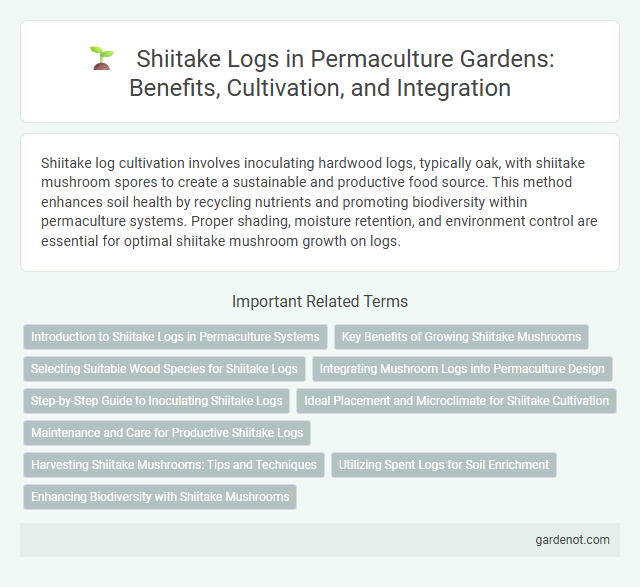Shiitake log cultivation involves inoculating hardwood logs, typically oak, with shiitake mushroom spores to create a sustainable and productive food source. This method enhances soil health by recycling nutrients and promoting biodiversity within permaculture systems. Proper shading, moisture retention, and environment control are essential for optimal shiitake mushroom growth on logs.
Introduction to Shiitake Logs in Permaculture Systems
Shiitake logs are a sustainable cultivation method using hardwood logs inoculated with shiitake mushroom spores, promoting natural decomposition and enriching forest soil in permaculture systems. These logs provide a perennial source of nutritious mushrooms while enhancing soil biodiversity and moisture retention. Integrating shiitake logs supports closed-loop nutrient cycling and increases overall ecosystem productivity in agroforestry designs.
Key Benefits of Growing Shiitake Mushrooms
Shiitake mushrooms cultivated on logs provide superior quality fruiting bodies rich in lentinan, enhancing immune system support and offering potent anti-inflammatory properties. Growing shiitake on hardwood logs, such as oak or sweetgum, ensures a sustainable, low-maintenance food source with natural nutrient recycling benefits for soil health. This method promotes biodiversity by supporting beneficial microflora and reducing reliance on synthetic inputs in permaculture systems.
Selecting Suitable Wood Species for Shiitake Logs
Selecting suitable wood species for shiitake logs is crucial for optimal mushroom growth, with oak, sweetgum, and beech being among the most effective due to their dense hardwood composition and nutrient content. Freshly cut logs from these species should ideally be 3 to 8 inches in diameter and cut during the dormant season to maximize moisture retention and reduce contamination risks. Proper wood selection directly influences the yield, quality, and shelf life of shiitake mushrooms in permaculture systems.
Integrating Mushroom Logs into Permaculture Design
Integrating shiitake mushroom logs into permaculture design enhances ecosystem diversity by recycling hardwood waste and providing a sustainable food source. Placing inoculated logs in shaded, moist areas promotes optimal fungal growth and nutrient cycling without disrupting existing plant systems. This approach supports soil health, encourages beneficial microbe activity, and contributes to a closed-loop agricultural system.
Step-by-Step Guide to Inoculating Shiitake Logs
Inoculating shiitake logs begins by selecting freshly cut hardwood logs, ideally oak or maple, with a diameter of 3-8 inches and cut within two weeks to maintain moisture and nutrient levels. Drill evenly spaced holes about 1 inch deep and 6 inches apart along the log's length, then insert shiitake spawn dowels into the holes using a rubber mallet, sealing each with wax to prevent contamination and moisture loss. Store the inoculated logs in a shaded, humid environment with good airflow, maintaining temperatures between 55-75degF to optimize colonization and mushroom fruiting over 6-12 months.
Ideal Placement and Microclimate for Shiitake Cultivation
Shiitake logs thrive best in shaded, humid environments with temperatures between 55-75degF (13-24degC), mimicking their natural forest habitat. Ideal placement involves positioning logs under deciduous trees or on the north side of structures to avoid direct sunlight and retain moisture. Maintaining a microclimate with high humidity and good air circulation ensures optimal mycelium growth and fruiting for Shiitake mushrooms.
Maintenance and Care for Productive Shiitake Logs
Maintaining productive shiitake logs requires regular monitoring of moisture levels, ensuring the logs remain consistently damp but not waterlogged to promote optimal fungal growth. Protecting logs from direct sunlight and extreme temperatures by placing them in shaded, humid environments helps sustain mycelium health and fruiting potential. Periodic assessment for pests and diseases, along with soaking logs in water for 24 hours during dry seasons, supports vigorous shiitake mushroom yields.
Harvesting Shiitake Mushrooms: Tips and Techniques
Harvest shiitake mushrooms from logs when caps are fully opened but before edges curl, ensuring optimal flavor and texture. Use a sharp knife to gently cut mushrooms at the base to avoid damaging the mycelium, promoting sustainable regrowth. Maintain proper moisture levels by soaking logs periodically to encourage consistent fruiting cycles during the growing season.
Utilizing Spent Logs for Soil Enrichment
Spent Shiitake logs retain valuable nutrients and organic matter that enhance soil health when incorporated into garden beds or compost piles. As the logs decompose, they boost microbial activity and improve soil structure, increasing water retention and nutrient availability for plants. Utilizing these spent logs in permaculture systems supports sustainable waste management and fosters a thriving, fertile ecosystem.
Enhancing Biodiversity with Shiitake Mushrooms
Shiitake mushroom cultivation on logs significantly enhances biodiversity by creating microhabitats that support various fungi, insects, and microorganisms. This method promotes soil health through nutrient cycling and organic matter decomposition, fostering a balanced ecosystem. Integrating shiitake logs into permaculture designs increases species diversity, resilience, and overall system productivity.
Shiitake log Infographic

 gardenot.com
gardenot.com